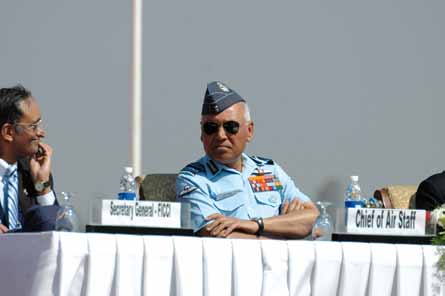Air force looks to speed up delivery of new fighters, but contest will not be rushed
India will overcome shortfalls in its operational capability by buying additional Sukhoi Su-30MKI fighters in the near term and boosting the aircraft's licensed-production rate at home, says the head of the Indian air force.
Delays to India's fighter competition and the induction of the indigenous Light Combat Aircraft (LCA) have "adversely affected" the number of combat squadrons, says Air Chief Marshal S P Tyagi. But he adds that the air force's operational capability has not dropped to a critical level.
"While there is a lag in the procurements vis-à-vis the phasing out, it is not alarming," says Tyagi. "The proposed compression of the delivery schedule of HAL [Hindustan Aeronautics]-built Su-30MKI aircraft will help check the depletion. We also plan to procure additional squadrons of fighter aircraft. We are upgrading our older fleets to effectively utilise them over their remaining service life."
|
|---|
Tyagi: "No bias towards any country" |
This does not mean that a decision on the multirole combat aircraft (MRCA) competition will be rushed. Tyagi, who refused to be drawn on when the long-awaited request for proposals (RFP) will be issued, would only say that an aircraft that fits India's requirements and budget will be chosen.
Sections within the air force are believed to favour the MiG-35 over its US and European rivals, arguing that Russia has been a reliable partner since the 1970s - when the Soviet Union and India were strategic geopolitical partners during the Cold War. But Tyagi denies that the country of origin will be a factor, pointing to past purchases of the UK's Hawk jet trainer and France's Dassault Mirage 2000.
"Over the years, the air force has procured equipment from various vendors depending on our operational requirement and the strategic compulsions. The strategic compulsions of bygone eras do not exist in the highly competitive defence industry of today," he says. "There would be no bias towards any country whose aircraft are currently being operated by the air force."
Others believe India should move away from Russian equipment due to the poor safety record - more than 150 Indian pilots have been killed while flying MiGs. Tyagi, however, says that the situation has improved. "Our experience indicates that Russian equipment is robust, cost-effective, and comparable with the best in the world. The accident rates of aircraft fleets of Russian and Western origin, of corresponding vintage, are similar," he adds.
The force's role in the coming years would be to support India's growing clout as an economic power, and the push for a strategic reach in the region, says Tyagi.
"The air force could be called upon to protect the sea lanes of communications securing our energy needs, as well as deployed at long ranges and at short notice to assist friendly neighbouring countries," he says.
The acquisition of an aerial refuelling capability has enhanced the air force's effectiveness in this respect, while the forthcoming search for fifth-generation fighters and the move into unmanned combat air vehicles would add to this, says Tyagi.
Source: Flight International

















